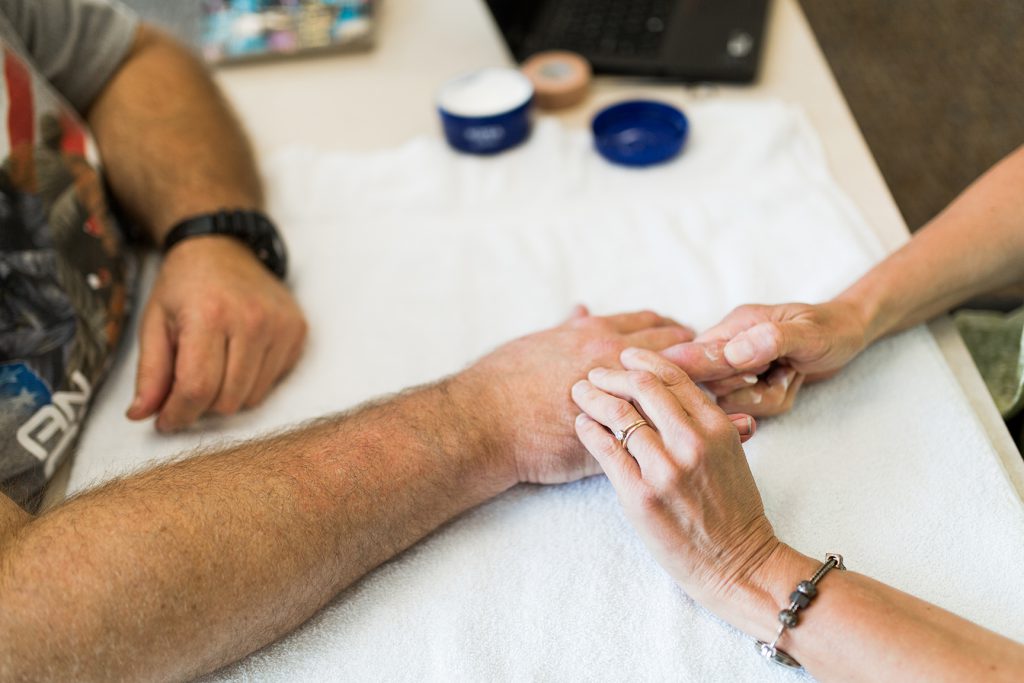Thumb arthritis pain can be debilitating, making ordinary tasks difficult to complete. If you suffer from thumb arthritis, pain is the most common symptom. Other symptoms include:
- Pain when you grip, grasp or pinch an object, or use your thumb to apply force.
- Swelling, stiffness and tenderness.
- Decreased strength in your hand and thumb.
- Decreased range of motion.
- Thumb and hand appear collapsed.
The good news is there are several options to relieve the symptoms of thumb arthritis, ranging from over the counter treatments and non-surgical therapies to surgical interventions.
Dr. James Baker, an affiliated hand surgeon and fellowship trained specialist with OrthoCincy Orthopaedics & Sports Medicine, who performs surgery at St. Elizabeth Healthcare, says there is no one treatment that can help with all symptoms but there are options.
He says, “I think it is important to work with patients on the least invasive options first. Then, if they have tried everything and still can’t live with the symptoms, there are several surgery options available. Every patient is different and your options for treatment will depend on your age, activity level and the amount and pattern of arthritis in your thumb.”
There are 10 options for the treatment of thumb arthritis:
- Over-the-counter supplements (Glucosamine & Chondroitin). While the research is inconclusive – there is very low risk to this daily low-cost therapy taken orally. Some patients experience relief not only for their thumb but other arthritic joints.
- Over-the-counter medicines. Alternating doses of high-dose Tylenol (acetaminophen) and anti-inflammatory medicines (Ibuprofen or Naprosyn) can often provide significant pain relief. However, there are contraindications to these medicines and long-term treatment must be taken under the direction and monitoring of your primary care physician.
- Topical Anti-inflammatory Medicine. There are over-the-counter analgesic creams that some patients find helpful. Prescription anti-inflammatory creams can be taken by patients that have contraindications to oral anti-inflammatory medicine. However, this solution can be expensive and insurance doesn’t always cover the entire cost.
- Soft Hand brace. An over-the-counter brace that is soft and functional can be worn during the day to provide support.
- Hard Hand Brace: If the soft brace doesn’t provide enough relief, a custom molded hard brace can be ordered and made by a certified hand therapist. The hard brace is typically worn at night only.
- Injections. A cortisone injection can relieve pain, but the effect is temporary and typically becomes less effective with every treatment.
- Ligament reconstruction and tendon interposition (LRTI) surgery. This is the most common procedure used for thumb arthritis. During the surgery, the trapezium bone (which is arthritic) is removed. Additionally, a tendon is harvested and transferred into the space where the bone was removed. This creates a soft cushion for the thumb. This procedure has an approximate 12-week period for full recovery. Some subsidence of the thumb metacarpal is expected but usually is not an issue.
- Hematoma distraction arthroplasty (HDA) surgery. In this procedure, only the trapezium bone is removed and a wire is often used to temporarily immobilize the thumb. The wire is removed approximately four to six weeks later.
- Joint replacement with an implant. A part of the entire basilar joint can be replaced. One example is the Stablyx hemi-arthroplasty, where an implant is used to resurface the base of the metacarpal bone to mimic and replace the damaged cartilage surface. The trapezium is recontoured to match the normal anatomy, removing the arthritic spurs. This allows you to keep a more natural structure and length of your thumb which may result in better range of motion, strength and more natural appearance. This procedure has a faster recovery period compared with the above procedures.
- Joint fusion. In this surgical procedure, the bones in the arthritic joint are fused together. Although this procedure can alleviate pain, there is a considerable loss of motion and the position of the thumb can be difficult for some patients to adapt to.
If you are suffering from thumb pain, you should make an appointment with a hand specialist to discuss your options for treatment. To schedule an appointment, please call our affiliated orthopaedic surgeons from OrthoCincy – Orthopaedics & Sports Medicine at (859) 301-BONE (2663).

